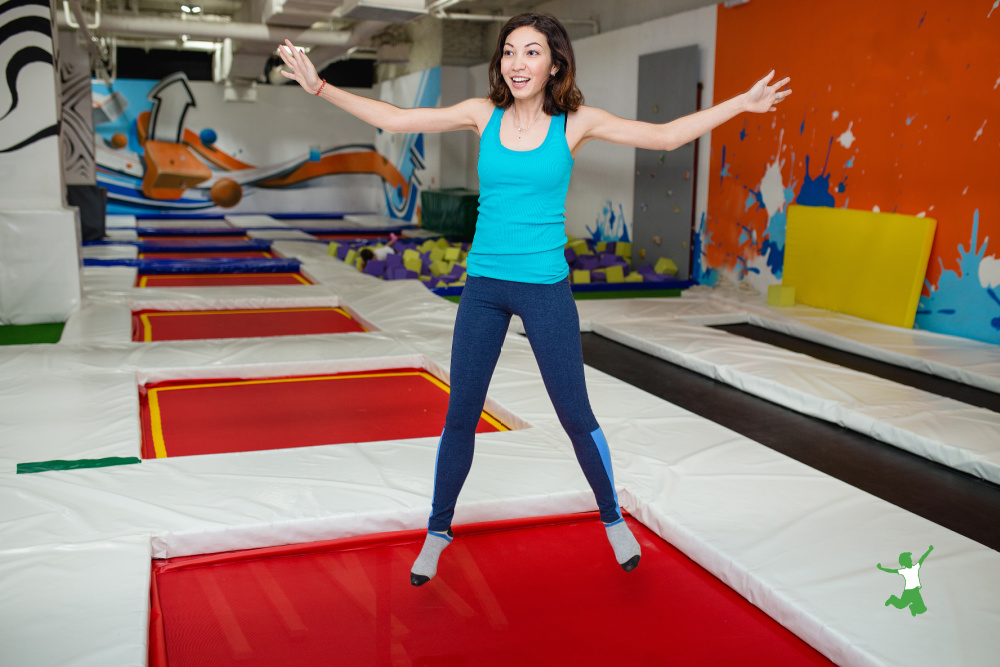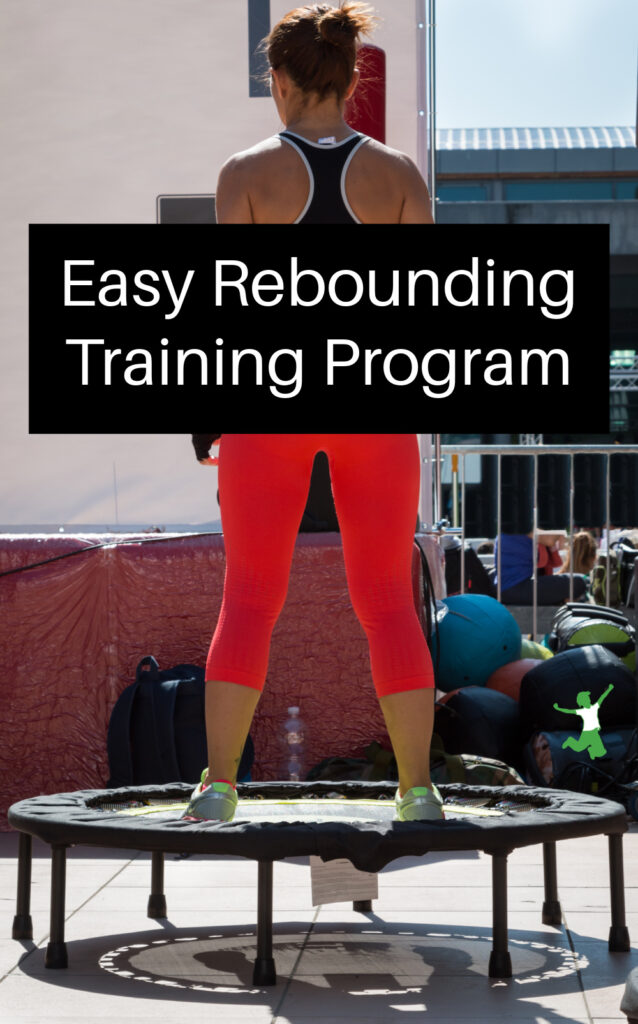Table of Contents[Hide][Show]
Rebounding has many health benefits and is a safe, fun, and easy way to get fit no matter what your level with this suggested training program.

Do you want the body of a Greek god or goddess? Is your ultimate fitness goal to look rock hard in your bikini or board shorts turning heads and making a splash at your local pool or beach?
Then lift heavy weights, sprint and eat a clean traditional diet.
You will need to consistently work very hard and be relentless in your pursuit. It ain’t easy being a fitness rock star.
“Uh, yeah, ok. Let me get right on that”—not your goal huh?
Perhaps you haven’t exercised for a few years, have gained quite a bit of weight and/or are working on overcoming health challenges.
Your goals are different.
You just want to feel better, sleep better, lose a little weight and be healthier!
You know you need to exercise or at least move but it’s tough to do so—some days it’s a challenge just to get out of bed or your schedule is so crammed you don’t have 60 min to devote to a workout let alone add in travel time. You’ve never lifted weights, don’t know where to start, don’t have access to a gym membership and can’t afford a trainer.
Is all hope lost?
No!
A great way to bounce back is rebounding your health (pun intended) using a Rebound Trainer. What is rebounding? It’s quite simply bouncing on a mini or large trampoline with its low impact, small controlled movements. It can be done while watching TV, listening to your favorite music, outside in the fresh air with your children.
Best of all, rebounding can be done by almost anyone at any level of fitness.
Many Benefits of Rebounding
- Increases cardiorespiratory fitness
- Improves circulation
- Improves coordination, accuracy, agility, and balance
- Tones and strengthens leg, hip, thigh, and core musculature
- Increases energy and revitalizes a tired body/mind
- Boosts lymphatic and immune system and aids in detoxification
- Protects joints from impact delivered by exercising on hard surfaces
- Can aid in reducing blood pressure
- Aids in managing body composition
- Benefits the alkaline reserve of the body
- Improves the vestibular system
- Enhances digestion and eliminations
- Improves mental performance
- Deeper and more restful sleep
- Reduces fatigue
- Helps user to regain control of life and a better self-image
The most important reason of all? FUN
For those looking for a safe and gentle exercise program that should be motivation enough. Before purchasing do some research to find the rebounding model best suited to your needs and budget. There are many brands, styles and price ranges to choose from. Visit your local sporting goods store first to try one out and then shop online for the best brands/deals/prices.
Once you’ve purchased your rebounder, how to start? Most will come with a guide, DVD or video. I would suggest first reading through and watching. If you’re brand new to exercise/movement follow these general guidelines. Remember; with any exercise program, it MUST be consistent and progressive. And always listen to your body.
Suggested Rebounding Training Program
Week 1:
Day 1: 2 min 3x a day
Day 2: 3 min 3x day
Day 3: 4 min 3x a day
Day 4: 5 min 2x a day
Day 5: 5 min 2x day
Day 6/7: 6 min 2x day
Start with simple, beginner moves such as heel lifts (lifting one heel then the other keeping soles on the mat), gentle jogging (bouncing slightly higher yet still keeping soles on the mat) and light bouncing (jumping no more than 4” from the mat)
Weeks 2-6:
Week 2: 8 min 2x day
Week 3: 10 min 2x da
Week 4 & 5: 15 min 1x day
Week 6+: 20 min 1x day
If you’re feeling comfortable on your rebounder after the first week and want to take it up a notch an intermediate approach would be jogging (at a brisker pace gradually lifting your knees higher) and jumping higher (around 6”) with your arms by your side or add them in to involve the upper body.
After a rock-solid 6 weeks of consistent and progressive rebounding if you’re ready to advance add weights, try seated bounces and jump higher! If attempting intermediate or advanced movements they should always be preceded by a warm-up of the beginner movements.
Follow any workout with gentle stretching. Every time we exercise we shorten muscles as they contract so it is equally important to elongate them. Stretch the calves, quads, hamstrings, and glutes and follow up with plenty of freshwater to flush out the toxins.
For fitness rock stars, don’t discount rebounding for only those “less fit”.
Rebounding can be a wonderful adjunct to your current program. Use at home or at the office for 5 – 10 minutes; it can revitalize you and reduce the stress on those overwhelming days we all have. It can also be used on an “active rest” day or as a warm-up/cooldown on exercise days. While it may not be the mainstay of your workout program you too can garner benefits.
No matter your goals, as always a healthy diet of the right quality and quantity foods is imperative for any type of training or health program to reach its ultimate potential. If you’re looking to start exercising, rehab from injuries, reduce stress, or just add variety to an existing program, rebounding could be just the ticket for your way back to health and vitality!









I have one it’s great!!! (Bob Hope had one in his bedroom!)
Hi Paula
Can you give a little more info on what an anti-inflammatory diet might look like
Avoiding processed/packaged foods, sugars, refined carbohydrates/grains and gluten. Eating fresh organic fruits/veggies, pastured meats/fowl, wild seafood and healthy fats. You know, if it tweren’t around 300 years ago you probably don’t want to eat it. . .
JumpSport is GREAT, and like Bellicon, is silent. Much cheaper, but very high quality.
I keep thinking about getting one of these.
I am wondering about how much of a difference there is between the more and less expensive ones. I have also heard that rebounding can be bad for feet? Is that true?
I usually opt for the middle of the road products initially unless it is something I am really going to use over a long period of time. I finally broke down and bought the White Mountain ice cream maker after first going through a mid grade one.
I would not think it would be bad for your feet however; if they are not used to the bouncing/jumping as with most everything starting slow and gradually building volume is best to allow the muscles and tendons in the feet to strengthen and adjust.
I can tell you first hand that all the cheap rebounders I went through caused me much pain. I have a bellicon which is very expensive. But Jump Sport makes a cheaper version of the bungee rebounder that I understand is very good as well.
I jump in bare feet. Strengthens the ankles, arches, toes … everything in my experience.
Thank you for this article. I have osteoarthritis in my knees so CrossFit and most other high impact workouts are out of the question for me.
Does anyone have suggestions for slowing the progression of osteoarthritis? I’m not even 50 yet! I stated in menopause at 48 and my knees have gone downhill from there. So discouraging. I hope to prolong knee replacement as long as possible.
Following an anti inflammatory diet can slow the progression.
hi, i’m wondering if rebounding is ok for the pelvic floor? what about during pregnancy? thanks!
Thank you for this beginner schedule! One suggestion I’d add is that mamas (especially mamas of many) may need to wear a pad while rebounding. Also, those with balance issues should get a rebounder with a balance bar or else do their jumping close to a counter or other good spot to grab if they start to topple.
Yes, this is true. I never had a issue in that department until after having kids.
Rebounding will help tighten those kegel muscles. Nice and strong after awhile as you have to tighten that core with every single jump. Good for resolving this common problem of post childbirth.
Great article! I have a bellicon and I love it. I get the bungees for above my weight class because I like a firmer/faster bounce so I can keep up with the beat of the music I’m listening to. Cheaper rebounders leave me in pain(knees, back, ankles), but I haven’t had any issues with this one. Plus it makes NO NOISE.
I have a Bellicon too and really love it!
Rebounding is a great exercise, but I would offer a word of caution. If your ankles tend to pronate, rebounding could cause some real damage down the road. I believe the Celliser listed deals with that issue. Also, getting a cheap rebounder with a hard bounce is not good for the hips. Rebounding moves the lymph, which doesn’t have a mechanism of its own. Some people don’t like the bouncing movement of a rebounder, but even if you sit on the edge of it and bounce, you are moving your lymph and getting “steps” in on a pedometer. Another way to achieve the two is bouncing on a big ball. Do it for 5 minutes, 3 times a day and you’ve gotten in 1500 steps.